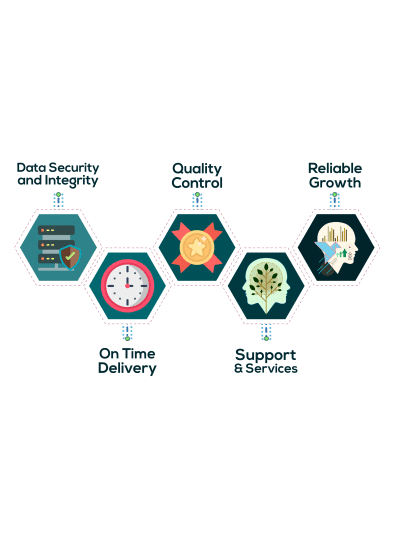
Understanding the Impact of AI-Driven Workflow Automations in SMEs
Businesses spent over $150 billion on AI-associated tech last year, and it’s the ability to automate essential processes and workflows which makes this breakthrough so appealing for organizations in every industry niche.
If you have yet to pull out all the stops and follow an artificially intelligent path to increased profitability, stick around as we look at the impact that this can have, and the ways around obstacles to adoption that exist.
Advanced AI Algorithms Enhancing SME Efficiency
AI algorithms have become more sophisticated and accessible over the past year, allowing small and medium-sized enterprises (SMEs) to streamline their operations significantly. Gone are the days when only large corporations could afford these cutting-edge technologies, and 93% of smaller firms now see the cost savings and profit-boosting potential as major selling points, although there are others, such as:
Intelligent Process Automation
AI-driven workflow automation employs advanced machine learning models to handle repetitive tasks efficiently.
Let’s say you run an accounting firm where tedious data entry can consume hours. In this case:
Automated data extraction tools pull relevant information from invoices.
Predictive analytics forecast cash flows based on historical data.
Natural language processing (NLP) streamlines customer support by answering routine queries instantly.
These innovations reduce human error and free up valuable time for strategic decision-making. And since data cleansing is also a time-intensive process, eating into as much as 70% of company time, it’s a boon for productivity as well.
Dynamic Resource Allocation
Dynamic resource allocation leverages AI to optimize workforce management. For instance, a retail company might use predictive scheduling to anticipate peak shopping times like so:
Algorithms analyze past sales patterns.
They adjust staffing levels in real-time.
This approach ensures that employees are allocated efficiently, improving service quality without incurring unnecessary labor costs.
Companies like Amazon have pioneered such practices, and now SMEs can follow suit with tailored solutions fitting their scale and budget.
The same benefits can apply in all sorts of other industries beyond retail. For instance, software that can automate the scheduling and routing for pest-control professionals allows optimal allocation of organizational resources, which is good for revenue generation as much as for customer satisfaction.
Inventory Management Optimization
Inventory management becomes more intuitive with the help of AI. Instead of relying on manual stock counts or outdated software:
Smart systems track inventory levels continuously.
Machine learning models predict stock outs before they happen based on sales trends and seasonal fluctuations. Since this issue could hit sales by as much as 9%, avoiding it is a must.
For example, an online bookstore could use these predictions to avoid overstocking slow-moving titles while ensuring bestsellers remain available.
Enhanced Decision-Making Processes
One key advantage is the enhancement of decision-making processes through actionable insights provided by advanced algorithms. Imagine a small manufacturing business evaluating new market opportunities – in this case:
Data aggregation tools compile relevant market data quickly.
Sentiment analysis gauges public opinion about potential product launches via social media monitoring platforms like Brandwatch or Hootsuite Insights.
These steps enable informed decisions backed by robust analytical support rather than gut feelings alone – drastically increasing success rates for new ventures or expansions into unfamiliar markets.
What’s next?
Integrating these smart systems isn’t always straightforward but offers immense rewards when done right, including improved productivity across departments which lead directly toward that all-important uptick in profits. And this is bolstering the AI market as a whole, with leader OpenAI seeing its value exceed $2 trillion.
Overcoming Common Challenges in Implementing AI Workflows
While the benefits of AI-driven workflow automation are clear, SMEs often face several hurdles during implementation. Identifying these challenges early on and addressing them proactively can make the transition smoother and more successful.
Factors include:
Technical Complexity
AI technology might appear intimidating to businesses without a strong technical foundation. Complex algorithms and integrations require specialized knowledge:
SMEs may lack in-house expertise.
Outsourcing to experts or training existing staff incurs additional costs.
However, solutions exist to bridge this gap. Low-code platforms like UiPath offer user-friendly interfaces that simplify automation tasks, reducing the need for extensive coding knowledge.
Data Quality Issues
Data quality plays a crucial role in AI efficacy, and this costs companies over $3 trillion annually. Inaccurate or incomplete data hampers algorithm performance, which is exacerbated by the fact that:
Small companies often have scattered or unstructured data sources.
Integrating disparate systems presents significant challenges.
Ensuring clean, well-organized datasets before deploying AI solutions is vital. Implementing robust data governance practices can help maintain high standards over time – think of it as setting up a solid foundation before building your dream house.
Change Management Resistance
Human factors also come into play when introducing new technologies:
Employees might fear job displacement due to automation, with one study suggesting that 43% of professionals are in this boat.
There may be resistance from those accustomed to traditional workflows.
Addressing these concerns transparently is essential for unrestricted adoption. To do this:
Highlight how automation complements rather than replaces human roles by taking over repetitive tasks while employees focus on strategic initiatives.
Provide comprehensive training to ensure everyone feels comfortable with new tools, greasing the wheels of transitioning over to increased automation.
Cost Constraints
Initial investment costs associated with implementing advanced AI systems can deter smaller businesses from pursuing these innovations.
These include:
Software licenses
Hardware upgrades
Consultancy fees
Exploring scalable options tailored specifically towards SME budgets proves beneficial here – for example cloud-based services such as Google Cloud’s AutoML offer flexible pricing models based on usage levels rather than hefty upfront fees.
Tackling Security Concerns
Another critical aspect involves ensuring robust cybersecurity measures are integrated within automated workflows. Safeguarding sensitive information becomes paramount especially considering potential vulnerabilities introduced via interconnected devices. For starters:
Conduct regular security audits
Implement multi-factor authentication protocols
Putting security at the top of the agenda, rather than only responding when problems arise post-adoption, is the best solution to fears.
Final Thoughts
As you can see, the benefits afforded to SMEs by AI automation in the workplace far outweigh the drawbacks. The point is that with proper planning and an approach to adoption that brings every employee onboard, you can find your way to a satisfactory state of affairs, rather than upsetting the applecart with thoughtless implementation.



